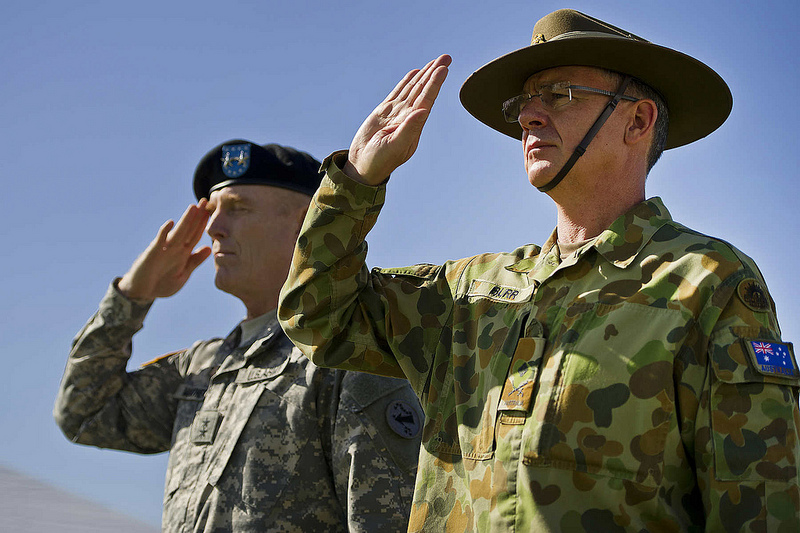Force Structure 103a: joint or combined?
Posted By Peter Layton on February 13, 2013 @ 05:00
For Australia, force structure decisions don’t solely revolve around national considerations. The alliance with America has a major influence. In thinking about force structures we have two choices at either end of a continuum: either develop an independent national joint force or instead field tactical units able to fit seamlessly into a larger American joint force. In practice we try to a bit of both, although this potentially builds two different and incompatible forces.
The heyday of the national joint force option was in the late 1980s and early 1990s under the Defence of Australia (DOA) rubric. A national command and control structure was established with the necessary communications systems that allowed independent operations. That proved handy in East Timor when Australia ended up providing the bulk of the forces and running the operation. Perhaps surprisingly, not all middle powers have such a command and control system. Many NATO nations, for example, don’t have a large national command structure that allows them to undertake distant independent operations. Instead, they are part of the NATO command and control system.
Under DOA, Australia’s force structure was skewed towards working as a joint force in pursuit of national objectives in the immediate region. Appropriate and unique operational concepts and doctrine were developed. Equipment acquisitions involved specifying requirements and selecting platforms that were most appropriate to these needs, even if it meant building unique ships (Anzac frigates), vehicles (the Bushmaster [2] Infantry Mobility Vehicle) and aircraft (Tiger ARH [3], Super Seasprite [4] and Wedgetail) that could fit into the carefully designed Australian ‘system of systems’, or modifying old designs for new roles like fitting Harpoon anti-ship missiles to the F-111 land strike aircraft.
But such a force proved inherently difficult to integrate easily into a larger American combined force designed on quite different principles. For example, when the time came to deploy forces to the Middle East in concert with the US in 1991 (Desert Storm), 1998 (Desert Fox) and 2003 (Operation Iraqi Freedom) it was realised that the electronic warfare fits of the ADF platforms the government wanted to send weren’t suitable for that theatre in both design and programming. In Iraq in 2003 when the opportunity arose to potentially send land forces, the Army lacked the equipment to allow it to easily fit in with, or meaningfully assist, a large American mechanised force. A small Special Forces group went instead.
Today, there are some who are attracted to a re-run of the independent joint force option, albeit in a revamped form. Michael Evans has advocated an expeditionary ADF [5], structured to conduct stability operations in the archipelago to Australia’s north or into the South West Pacific: a ‘doing East Timor better’ force structure. Hugh White more ambitiously advocates an expanded ADF [6] able to defend Australia from a hostile great power—a 1987 DOA construct on steroids.
The alternative is fielding tactical units that are readily able to join a large American joint force. This approach got a big run in the 2000s, driven by the demands of the American-led wars in Afghanistan and Iraq. The ability to fit seamlessly into a much larger American force became the key capability driver.
Issues of command and control under this approach could be greatly simplified by acquiring appropriate communications equipment and adopting American operational concepts and doctrine. Similarly, it made sense to buy off-the-shelf American equipment that was already integrated into the American command and control structure and their logistic support system. By not needing to be specified as key nodes of an Australian-unique system of systems, equipment acquisitions didn’t need elaborate acquisition processes. Quick decisions could be made, such as on the JSF, Collins Class Combat Data System Replacement and weapons [7], the Aegis combat system and radar [8] for the Air Warfare Destroyer and the Abrams tank [9].
Going exclusively the US joint force way would inevitably result in some real loss of our capability to pursue independent operations. So the option most often espoused is to try to do both simultaneously: have a national joint force with elements that fit seamlessly into a combined American force. Inherently this is not an off-the-shelf solution, and it involves building unique platforms and systems, is easily the most expensive route and, as the 1990s showed, can be technically problematic when it comes to the crunch.
In the age of austerity, it might be necessary to be pragmatic and chose one or the other when considering force structure elements. Which elements need to be joint and which combined? Is it sensible in terms of effectiveness and efficiency to have a bit of both—to have dual force structures in effect? What does the new National Security Strategy [10] and our emerging strategic circumstances suggest our next Defence White Paper should choose?
Peter Layton is undertaking a research PhD in grand strategy at UNSW. Image courtesy of Flickr user US Army [11].
Article printed from The Strategist: https://www.aspistrategist.org.au
URL to article: https://www.aspistrategist.org.au/force-structure-103a-joint-or-combined/
URLs in this post:
[1] Image: http://www.aspistrategist.org.au/wp-content/uploads/2013/02/8391899123_ed6860ecda_c.jpg
[2] Bushmaster: http://en.wikipedia.org/wiki/Bushmaster_Protected_Mobility_Vehicle
[3] Tiger ARH: http://en.wikipedia.org/wiki/Eurocopter_Tiger
[4] Seasprite: http://www.australiandefence.com.au/5FB79830-F807-11DD-8DFE0050568C22C9
[5] an expeditionary ADF: http://www.quadrant.org.au/magazine/issue/2012/10/the-essential-service
[6] an expanded ADF: http://www.themonthly.com.au/why-australias-defence-all-sea-middling-power-hugh-white-6161
[7] Combat Data System Replacement and weapons: http://www.aph.gov.au/About_Parliament/Parliamentary_Departments/Parliamentary_Library/pubs/rp/rp0102/02RP03#unresolvedissue
[8] Aegis combat system and radar: http://www.smh.com.au/news/national/destroyers-to-get-1b-upgrade/2005/12/09/1134086783840.html
[9] Abrams tank: http://www.anao.gov.au/Publications/Audit-Reports/2007-2008/Acquisition-of-the-ABRAMS-Main-Battle-Tank
[10] new National Security Strategy: http://www.dpmc.gov.au/national_security/national-security-strategy.cfm
[11] US Army: http://www.flickr.com/photos/soldiersmediacenter/8391899123/
Click here to print.
